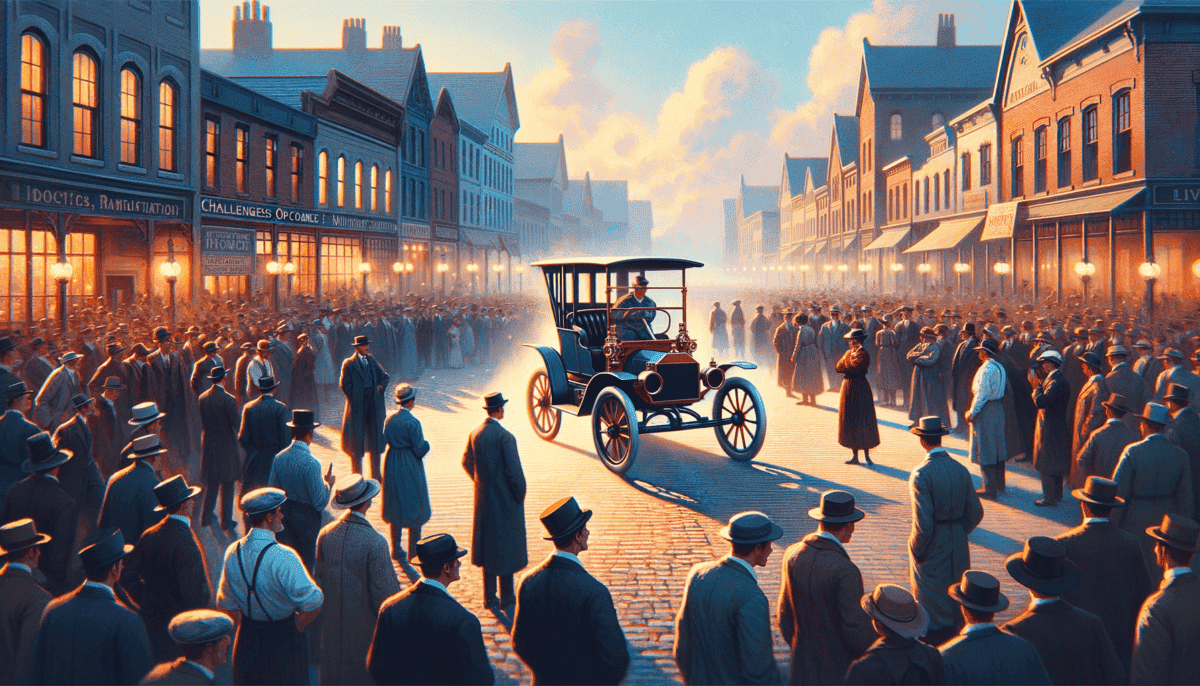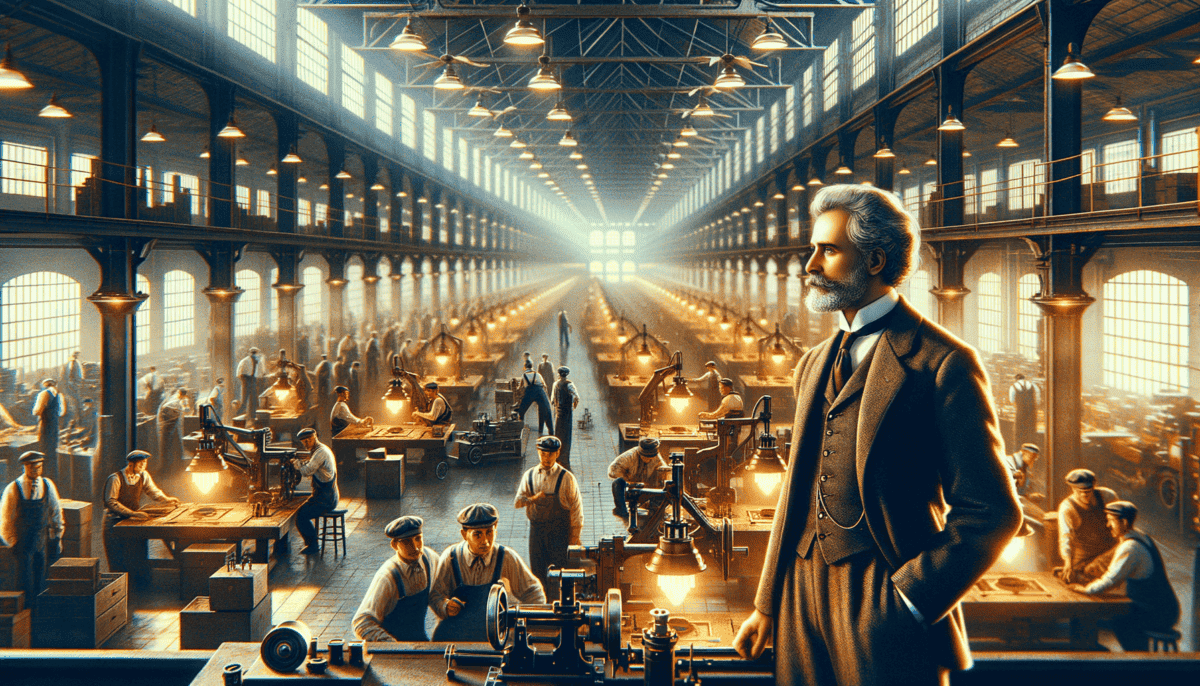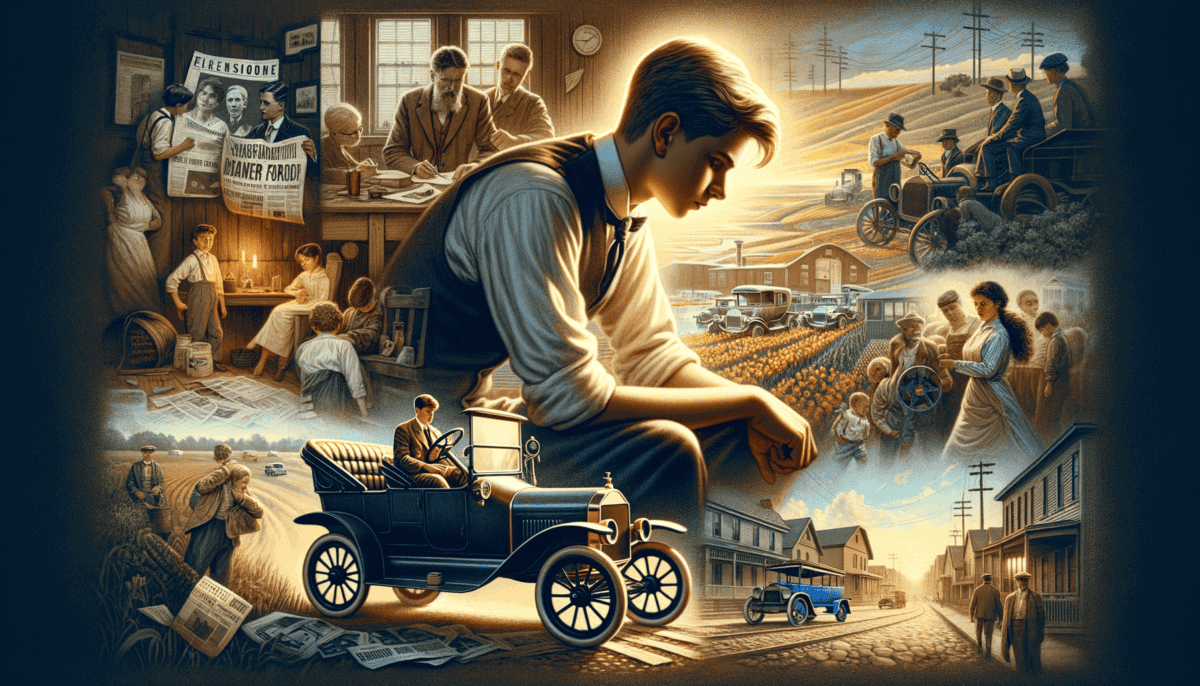Little Henry’s Big Dreams
On a sunny morning in 1869, nine-year-old Henry Ford sat under an apple tree on his family's farm in Michigan. The warm breeze carried the sweet smell of fresh hay as he tinkered with a small pocket watch. His blue eyes sparkled with curiosity as his nimble fingers carefully took apart the tiny gears.
"Henry!" his mother called from the farmhouse. "Time for breakfast!"
"Just a minute, Mother!" Henry replied, not taking his eyes off the delicate parts spread across his lap.
Henry loved to understand how things worked. He would take apart anything he could find – clocks, music boxes, and even farm tools.
The farm was a busy place. Horses pulled heavy plows through the fields while workers planted corn and wheat. But young Henry didn't dream about becoming a farmer like his father. He dreamed of something different – machines that could move without horses!
“There must be a better way,” Henry would say to himself as he watched the horses strain with their heavy loads.
One day, Henry and his father William were walking to town when they saw something amazing. A huge steam engine rolled down the dirt road, puffing clouds of white smoke. Henry's eyes grew wide with wonder.
"What is that, Father?" Henry asked excitedly.
"That's a steam engine, son. It's the future," William replied.
At night, Henry would sit at the kitchen table with bits of metal and tools spread out before him. His mother Mary would smile as she watched him work.
"What are you making now, dear?" she would ask.
"I'm not sure yet," Henry would reply with a grin. "But it's going to be something special!"
By age 12, Henry could fix any watch in the county. People started bringing their broken timepieces to the Ford farm, knowing the young boy could make them tick again.
"How do you do it?" his friends would ask.
Henry would shrug and say, "I just like to figure things out."
But fixing watches was just the beginning. Henry started building his own tools and machines. He made a small waterwheel in the creek behind the barn. He created gadgets to make farm work easier.
Not everyone understood Henry's passion. Some neighbors thought he was wasting his time with all his tinkering.
"A farmer's son should focus on farming," they would say.
But Henry's parents saw something special in their curious boy. They gave him a workbench in the shed where he could experiment with his ideas.
One evening, as Henry worked late into the night, his father came to check on him.
"Son," William said softly, "whatever you decide to do with your life, make sure it makes you happy."
Henry looked up from his work, his hands covered in grease, and smiled. He knew then that his future wouldn't be in the fields – it would be in workshops and factories, creating something that would help people move faster than any horse could run.
And so, under that Michigan sky, surrounded by fields and farms, a young boy's dream began to take shape. It was a dream that would one day put America on wheels and change the way people lived forever.
What Henry didn't know yet was that his simple love of machines would grow into something much bigger than he could imagine. But that's how all great stories start – with a curious child who isn't afraid to dream big.
Moving to the Big City
The year was 1879, and Henry Ford was ready for his next big adventure. At nineteen years old, he packed his tools in an old wooden box and said goodbye to the farm. Detroit, the bustling city of opportunity, was calling his name. ️
“Are you sure about this, Henry?” his mother asked, worry in her eyes.
“Yes, Mother. I need to learn more about engines and machines,” Henry replied with determination.
In Detroit, Henry found work as an apprentice machinist at the Michigan Car Company. The factory was huge and noisy, filled with the sounds of metal clanking and steam hissing.
“Watch carefully,” his boss James told him. “These machines need to be treated with respect.”
Henry learned quickly. His hands were always busy, fixing and building. At night, he would work on his own projects in a small rented workshop.
“I will build a car that everyone can afford,” Henry would say to himself as he worked late into the night.
But building a car wasn’t easy. His first attempts didn’t work very well. Some people laughed at his ideas.
“Cars are just toys for rich people,” they would say.
“You’ll never make it work,” others told him.
But Henry didn’t give up. He met a kind man named Thomas Edison at a dinner party. Edison listened to Henry’s ideas about building cars.
Those words gave Henry new energy. He worked harder than ever. Sometimes his experiments failed. Parts would break, engines wouldn’t start. But each failure taught him something new.
One day, after many tries, Henry built his first working car. It looked like a bicycle with an engine. He called it the Quadricycle.
People started to notice Henry’s work. Some businessmen offered to help him start a company. But their ideas were different from Henry’s dream.
“We should make fancy cars for rich people,” they said.
Henry shook his head. “No, I want to make cars that workers can buy. Cars that will help everyone.”
He tried starting two companies, but they didn’t work out. Still, Henry kept trying. He knew his idea was good. He just needed to find the right way to make it happen.
Late one night, as Henry walked home from his workshop, he looked up at the stars over Detroit. The city had changed him. It had taught him that big dreams take time, hard work, and lots of tries to come true.
The streets of Detroit were still filled with horses and carriages. But soon, very soon, Henry Ford would change that forever. His biggest success was just around the corner, even though he didn’t know it yet.
A Car for Everyone
The morning of October 1, 1908, was special. Henry Ford stood proudly next to his newest creation – the Model T car. It was painted black and looked simple but strong.
“This is the car that will change everything,” Henry told his workers with a big smile.
People were excited to see the new car. They gathered around it in crowds.
“Look how simple it is!” one person said.
“And I might actually be able to buy one!” said another.
The Model T was different from other cars in many ways:
• It was strong enough to drive on rough country roads
• It was easy to fix
• It used parts that were easy to find
• It was light and fast
• Most importantly, it was cheap!
“I will build a motor car for the great multitude,” Henry had promised. Now he was keeping that promise.
Orders started coming in fast. More people wanted Model Ts than Henry’s factory could make.
The Model T changed how people lived. Farmers could drive to town more easily. Families could visit friends who lived far away. Workers could live farther from their jobs.
Henry kept working to make the cars better and cheaper. Every year, the price of the Model T went down. More and more people could buy one.
“Remember when only rich people had cars?” kids would ask their parents.
“That was before Henry Ford’s Model T,” parents would answer.
Not everything was perfect. Sometimes the cars had problems. The factory couldn’t make them fast enough. But Henry and his team kept trying to make things better.
One day, a farmer drove his new Model T to Henry’s factory. His eyes were bright with happiness.
“Mr. Ford,” he said, “this car has changed my life. I can get to town in minutes instead of hours. Thank you!”
That made Henry very happy. His dream wasn’t just about making cars. It was about making life better for regular people.
As the sun set over Detroit that evening, Henry watched hundreds of Model Ts leaving his factory. Each one was going to a new home, to a family that had never owned a car before.
But Henry wasn’t done yet. He had another big idea that would make cars even cheaper and faster to build. The assembly line was coming, and it would change everything again.
Building Cars Faster
The year was 1913, and Henry Ford had a problem. His factory couldn’t make Model T cars fast enough!
“There must be a better way,” Henry said, watching his workers build cars one at a time.
One day, Henry visited a meat-packing plant. He saw how the workers stayed in one spot while the meat moved past them on hooks. A big smile spread across his face.
“What if we moved the cars instead of the workers?” Henry asked his team.
Everyone worked hard to try this new idea. They built a moving line that would carry car parts past the workers. Each worker would do just one job as the car moved by.
“This will make building cars as easy as putting together a toy!” Henry told his workers.
The first assembly line was ready in April 1913. Workers stood in their spots, waiting to see if it would work.
The moving belt started to roll. Parts moved smoothly from worker to worker. Each person did their special job:
• One person put on wheels
• Another added seats
• Someone else attached the steering wheel
• And so on, until the car was finished!
“Look how fast we’re making cars now!” workers said with pride.
The assembly line changed everything. Cars became cheaper to make, so Henry could sell them for less money. A Model T that once cost $825 now cost only $260!
Some workers found the assembly line boring because they did the same job all day. Henry knew this, so he did something special. He started paying workers $5 a day – twice what other factories paid!
“Now my workers can buy the cars they help build,” Henry said with satisfaction.
Other factories saw how well the assembly line worked. Soon, they started using it too. It wasn’t just for cars anymore – all kinds of things were made on assembly lines.
One worker named Tom had been at the factory before and after the assembly line. A reporter asked him what he thought about the change.
“At first, I wasn’t sure about doing the same thing all day,” Tom said. “But now I can work faster and make more money. And more people can buy our cars. That makes me proud!”
The assembly line was working better than Henry had ever dreamed. His factory was making more cars than all other car makers combined!
As Henry watched the cars roll off the assembly line that evening, he smiled. His new way of building cars was changing the world again. But with all this success came new challenges that Henry would soon have to face.
Growing Pains
By 1914, Henry Ford’s factory was making more cars than ever! But being a big boss came with big problems.
“Mr. Ford, the workers are unhappy,” said James, his factory manager one morning.
Henry walked through his factory, watching the assembly line move. He saw tired faces.
“What’s wrong, Bill?” Henry asked one of his oldest workers.
“Well, sir,” Bill replied, wiping his forehead, “doing the same thing every day isn’t much fun. Some folks are quitting.”
“We need to make things better for our workers,” Henry told his managers. “Happy workers make better cars!”
Other car makers were giving Henry trouble too. They wanted to build cars like his Model T, but cheaper.
Some people didn’t like Henry’s ideas about running his business. They wrote mean things about him in newspapers. But Henry kept focusing on making cars better and cheaper.
One day, a young worker named Sam came to Henry with an idea.
“Mr. Ford,” Sam said, “what if we had music playing while we work? It might make the day more fun!”
Henry loved this idea! Soon, the factory had music playing, and workers seemed happier.
Not everything Henry did made people happy. Sometimes he was stubborn about his ideas. He only wanted to make the Model T in black, even when customers asked for different colors.
“Any customer can have a car painted any color that he wants, so long as it is black,” Henry would say with a smile.
By 1918, half of all cars in America were Model Ts! But other car makers were catching up. They made cars in pretty colors and with new features.
Henry’s son Edsel tried to tell him they should make changes.
“Father, people want different kinds of cars now,” Edsel said.
“The Model T is perfect as it is!” Henry replied firmly.
The factory kept making black Model Ts, but fewer people were buying them. Henry would soon learn that sometimes being stubborn isn’t good for business. Change was coming, whether he liked it or not.
One evening, as Henry watched the sunset from his office window, he thought about all the changes in his life. He had changed how cars were made, but now he needed to learn how to change himself.
A New Road Ahead
The year was 1927, and Henry Ford stood in his factory looking at the last Model T ever made.
“Times are changing, Father,” Edsel said softly. “People want something new.”
Henry nodded slowly. “You were right, son. We need to make something different.”
Together, Henry and Edsel worked on a new car called the Model A. It came in pretty colors like green, red, and blue!
“This is what people want!” customers said when they saw the new car. “It’s beautiful!”
Henry watched as his ideas changed America. Where there used to be horse paths, now there were wide roads. Families could drive to visit relatives who lived far away. Farmers could take their food to sell in big cities.
“Now they’re everywhere!” Henry replied with a smile.
In his later years, Henry built a special museum called Greenfield Village. It showed how America had changed from horse-and-buggy days to the age of cars.
“Grandpa, tell us about when you built your first car!” his grandchildren would say.
Henry would smile and tell them about working in that little shed behind his house, about all the times his engine wouldn’t start, and about never giving up.
• Cars became something everyone could have
• Assembly lines made things cheaper to make
• Workers got better pay and shorter work days
• Roads and highways connected the whole country
Even today, many years later, we can see how Henry Ford’s ideas changed the world. Cars still roll off assembly lines, just like he invented. Workers still use many of the fair work rules he created.
One day near the end of his life, Henry sat in a modern car factory. The machines hummed, and robots helped build cars. It was very different from his first workshop.
“What do you think about all this?” someone asked him.
Henry smiled and said, “Every time I see a car on the road, I remember that little farm boy who just wanted to make machines work better.”
Today, when we see cars zooming down highways or factories making new things, we can thank that curious farm boy who never stopped dreaming big dreams.






